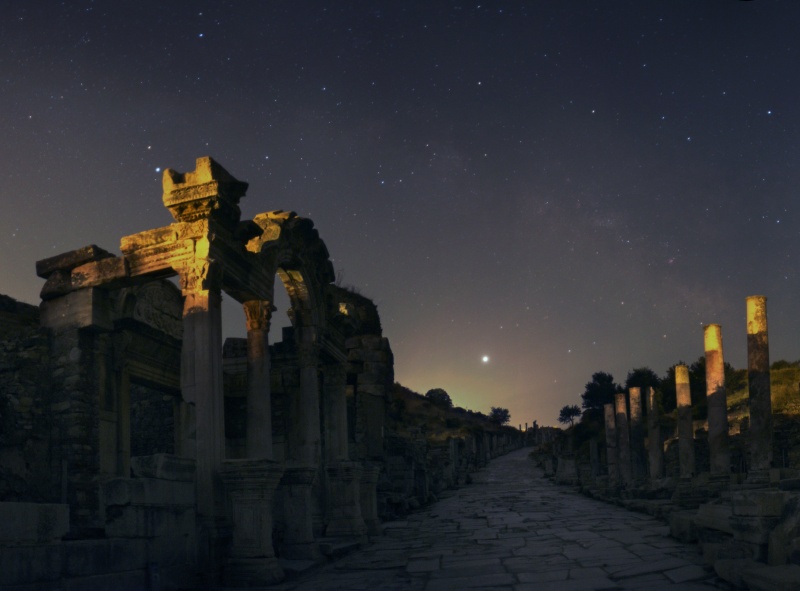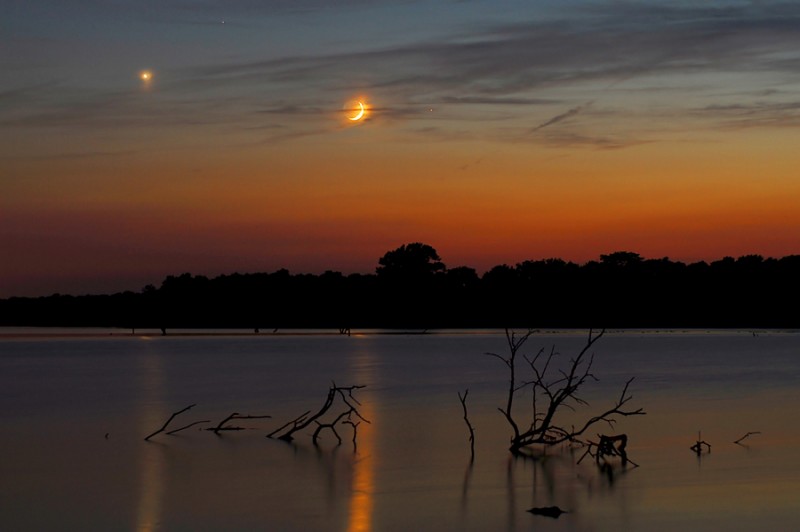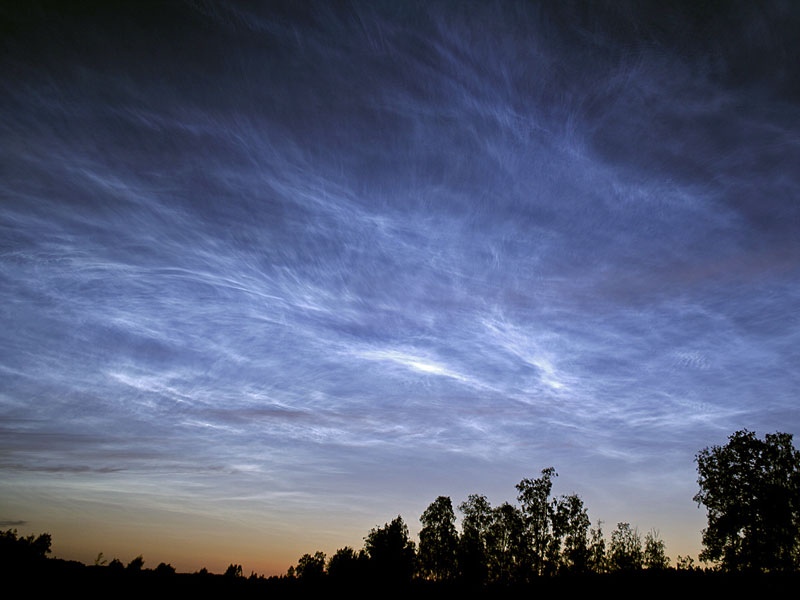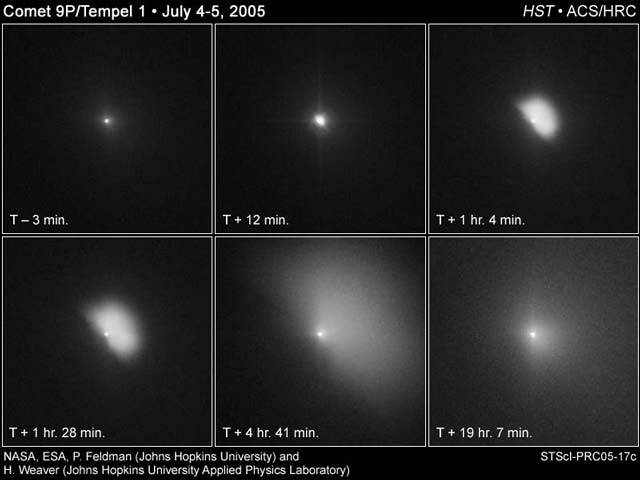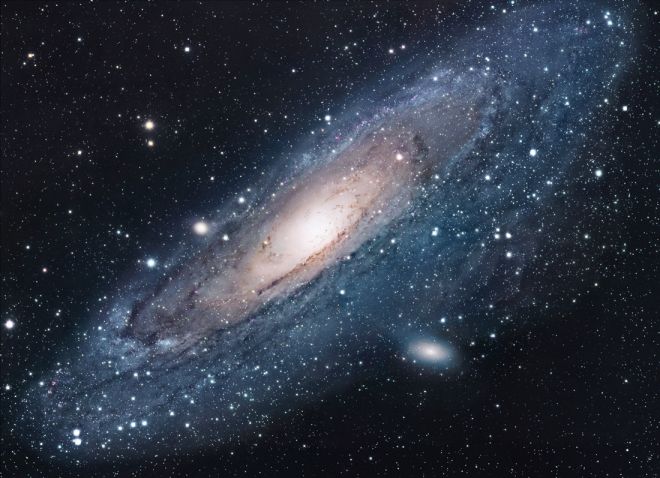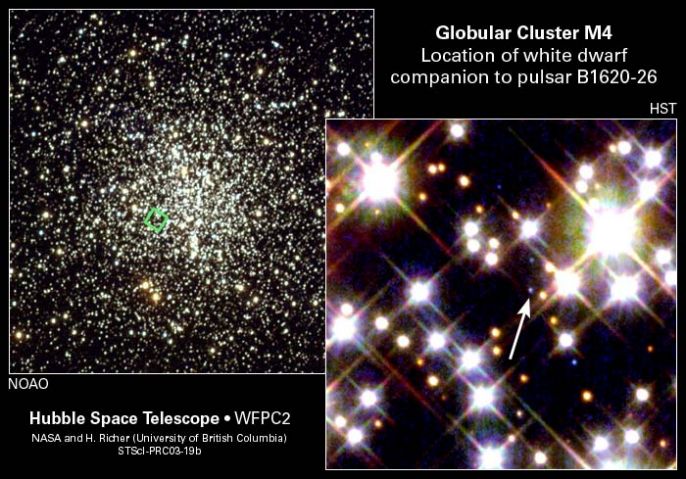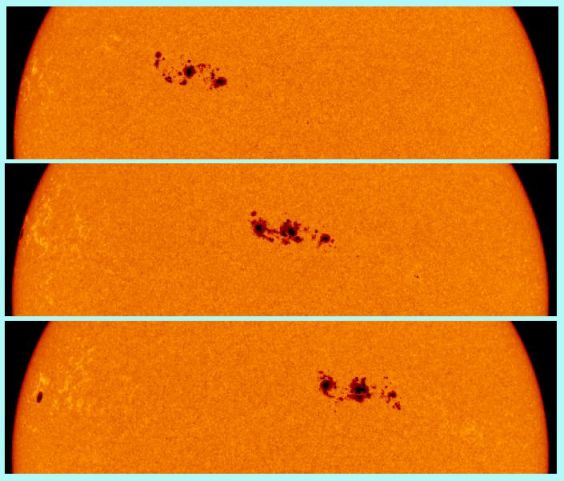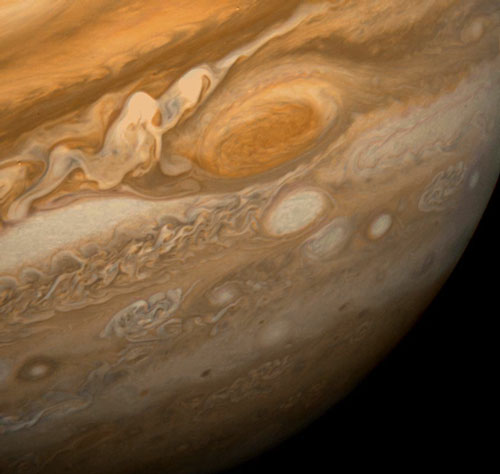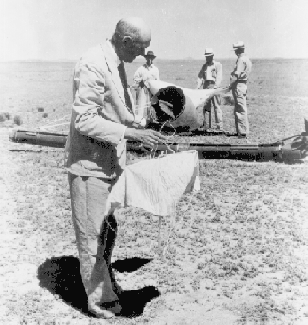| << Previous | Index | Next >> |
2015
Click to play embedded YouTube video.
Video Credit: NASA, Johns Hopkins Univ./APL, Southwest Research Inst.
2014 A mysterious, squid-like apparition, this nebula is very faint, but also very large in planet Earth's sky. In the mosaic image, composed with narrowband data from the 2.5 meter Isaac Newton Telescope, it spans some 2.5 full moons toward the constellation Cepheus. Recently discovered by French astro-imager Nicolas Outters, the remarkable nebula's bipolar shape and emission are consistent with it being a planetary nebula, the gaseous shroud of a dying sun-like star, but its actual distance and origin are unknown. A new investigation suggests Ou4 really lies within the emission region SH2-129 some 2,300 light-years away. Consistent with that scenario, the cosmic squid would represent a spectacular outflow of material driven by a triple system of hot, massive stars, cataloged as HR8119, seen near the center of the nebula. If so, this truly giant squid nebula would physically be nearly 50 light-years across.
2013 Similar in size to large, bright spiral galaxies in our neighborhood, IC 342 is a mere 10 million light-years distant in the long-necked, northern constellation Camelopardalis. A sprawling island universe, IC 342 would otherwise be a prominent galaxy in our night sky, but it is hidden from clear view and only glimpsed through the veil of stars, gas and dust clouds along the plane of our own Milky Way galaxy. Even though IC 342's light is dimmed by intervening cosmic clouds, this deep telescopic image traces the galaxy's obscuring dust, blue star clusters, and glowing pink star forming regions along spiral arms that wind far from the galaxy's core. IC 342 may have undergone a recent burst of star formation activity and is close enough to have gravitationally influenced the evolution of the local group of galaxies and the Milky Way.
2012 What created this unusual hole in Mars? The hole was discovered by chance on images of the dusty slopes of Mars' Pavonis Mons volcano taken by the HiRISE instrument aboard the robotic Mars Reconnaissance Orbiter currently circling Mars. The hole appears to be an opening to an underground cavern, partly illuminated on the image right. Analysis of this and follow-up images revealed the opening to be about 35 meters across, while the interior shadow angle indicates that the underlying cavern is roughly 20 meters deep. Why there is a circular crater surrounding this hole remains a topic of speculation, as is the full extent of the underlying cavern. Holes such as this are of particular interest because their interior caves are relatively protected from the harsh surface of Mars, making them relatively good candidates to contain Martian life. These pits are therefore prime targets for possible future spacecraft, robots, and even human interplanetary explorers.
2011 What's that astronaut doing? Unloading a space shuttle -- for the last time. After the space shuttle Atlantis docked with the International Space Station (ISS) last week, astronaut Mike Fossum underwent a long spacewalk that included carrying a Robotics Refueling Mission (RRM) payload from Atlantis' cargo bay to a platform used by the space station's famous robot DEXTRE. On Earth, the RRM box would have the weight of about three people and be much more difficult to carry. Pictured above on the far left, DEXTRE prepares to help move a failed space pump back to Atlantis. Visible behind the astronaut is the space station's Kibo Experimental Module. The much awaited final shuttle return flight is currently scheduled for 5:56 am EDT Thursday, July 21.
2010 Two galaxies are squaring off in Corvus and here are the latest pictures. But when two galaxies collide, the stars that compose them usually do not. That's because galaxies are mostly empty space and, however bright, stars only take up only a small amount of that space. During the slow, hundred million year collision, one galaxy can still rip the other apart gravitationally, and dust and gas common to both galaxies does collide. In this clash of the titans, dark dust pillars mark massive molecular clouds are being compressed during the galactic encounter, causing the rapid birth of millions of stars, some of which are gravitationally bound together in massive star clusters.
2009 This dramatic skyscape was recorded during the August 2008 total solar eclipse. The Moon's silhouette surrounded by a glistening solar corona hangs above the Jiayuguan Fort along the western edge of the Great Wall of China. Lined-up along the ecliptic plane, all the planets of the inner solar system, Mercury, Venus, Mars, (and Earth!) can also be seen along with Saturn and bright star Regulus, as the Moon's shadow tracks across the landscape. Beyond the Moon's shadow, outside the total eclipse track, sunlight still brightens the sky over mountains on the horizon 30 - 50 kilometers away. Much anticipated, the 2009 July 22nd total solar eclipse will again be visible from China. Planets and bright stars will briefly appear in darkened daytime skies, though a total eclipse won't be seen from the Great Wall. Still, major cities and populated areas lie along the 2009 total eclipse track that begins in India and sweeps eastward across Asia and into the Pacific Ocean.
2008 A brilliant Jupiter shares the sky with the Full Moon tonight. Since Jupiter is near opposition, literally opposite the Sun in planet Earth's sky, Jupiter will rise near sunset just like the Full Moon. Of course, opposition is also the point of closest approach, with Jupiter shining at its brightest and offering the best views for skygazers. Recorded late last month, this moving skyscape features Jupiter above the southeastern horizon and the marbled streets of the ancient port city of Ephesus, located in modern day Turkey. At the left is a temple dedicated to the Roman emperor Hadrian. The beautiful night sky also includes the arc of the northern summer Milky Way. Lights on the horizon are from the nearby town of Selçuk. Clicking on the image will download the scene as a panorama.
2007 Beautiful sunset sky colors are reflected in Pony Express Lake in this twilight skyview from northern Missouri, USA, planet Earth. Recorded on Monday, a two day old crescent Moon and brilliant planet Venus shine through thin clouds. Joining the conjunction on the right of the Moon's sunlit crescent is fellow wanderer Saturn, with Regulus, alpha star of the constellation Leo, above and right of Venus. Moonlight and Venus light streak the almost-calm lake waters.
2006 Sometimes it's night on the ground but day in the air. As the Earth rotates to eclipse the Sun, sunset rises up from the ground. Therefore, at sunset on the ground, sunlight still shines on clouds above. Under usual circumstances, a pretty sunset might be visible, but unusual noctilucent clouds float so high up they can be seen well after dark. Pictured above last month, a network of noctilucent clouds cast a colorful but eerie glow after dusk near Vallentuna, Sweden. Although noctilucent clouds are thought to be composed of small ice-coated particles, much remains unknown about them. Recent evidence indicates that at least some noctilucent clouds result from freezing water exhaust from Space Shuttles.
2005 It was a human-made event visible across the Solar System. At the direction of terrestrial scientists, a refrigerator-sized probe from the Deep Impact mission struck Comet Tempel 1 on July 4 at over 35,000 kilometers per hour. The unexpectedly bright explosion was not nuclear but rather originated from a large plume that reflected back sunlight. Pictured above is how the event looked to the Earth-orbiting Hubble Space Telescope. A large cloud of bright material is seen emanating from the comet's nucleus and then dispersing. The area encompassing the comet became over two times brighter in the hours after the impact. Astronomers will continue to study the images and data returned by Deep Impact to better determine the nature of Comet Tempel 1 and discern clues about the formation dynamics of the early Solar System.
2004 Andromeda is the nearest major galaxy to our own Milky Way Galaxy. Our Galaxy is thought to look much like Andromeda. Together these two galaxies dominate the Local Group of galaxies. The diffuse light from Andromeda is caused by the hundreds of billions of stars that compose it. The several distinct stars that surround Andromeda's image are actually stars in our Galaxy that are well in front of the background object. Andromeda is frequently referred to as M31 since it is the 31st object on Messier's list of diffuse sky objects. M31 is so distant it takes about two million years for light to reach us from there. Although visible without aid, the above image of M31 is a digital mosaic of 20 frames taken with a small telescope. Much about M31 remains unknown, including how the center acquired two nuclei.
2003 A planet, a white dwarf, and a neutron star orbit each other in the giant globular star cluster M4, some 5,600 light-years away. The most visible member of the trio is the white dwarf star, indicated above in an image from the Hubble Space Telescope, while the neutron star is detected at radio frequencies as a pulsar. A third body was known to be present in the pulsar/white dwarf system and a detailed analysis of the Hubble data has indicated it is indeed a planet with about 2.5 times the mass of Jupiter. In such a system, the planet is likely to be about 13 billion years old. Compared to our solar system's tender 4.5 billion years and other identified planets of nearby stars, this truly ancient world is by far the oldest planet known, almost as old as the Universe itself. Its discovery as part of an evolved cosmic trio suggests that planet formation spans the age of the Universe and that this newly discovered planet is likely only one of many formed in the crowded environs of globular star clusters.
2002 The solar active region designated number 10030 (or simply region 30) is now appearing on the visible hemisphere of the closest star. Dwarfed by the Sun's disk, the group of sunspots which make up region 30 actually cover an enormous area -- nearly 10 times the size of Earth. The panels above were recorded July 15, 16, and 17 (top to bottom) by the MDI instrument on the space-based SOHO Observatory as the solar rotation slowly carried the large, dynamic sunspot group across the Sun's nearside. On July 15, a powerful solar flare erupted from this region followed by a coronal mass ejection. The energetic cloud of electrically charged particles swept past our fair planet yesterday, and as a result enhanced auroral activity is possible.
2001 Last month, Mars and Earth were right next to each other in their orbits. Formally called opposition, the event was highlighted by a very bright Mars for skywatchers and a good photo opportunity for the Hubble Space Telescope. Above, Hubble snapped the highest resolution picture of Mars ever obtained from the Earth. Visible on Mars are ice caps over the poles in white, regions covered with sand and gravel in dark brown and orange, and large dust storms in light orange. A particularly large dust storm can be seen on the lower right pouring out of Hellas Basin. This storm has since erupted into a huge planet wide storm that continues even today. Pictures like these allow planetary astronomers to continue to compare the weather patterns of Mars and Earth. When Mars next reaches opposition in 2003, its elliptical orbit will cause it to be even 20 percent closer.
2000 The Russian Proton rocket is the tallest rocket in routine use. First deployed in 1965, the rocket stands typically 40 meters tall, can carry unusually heavy payloads into space, and maintains a high record of reliability. The Proton can be configured to launch satellites into orbit, to carry modules to a space station, and to carry people. The satellites a Proton Rocket has launched include Iridium, GRANAT, and, just last month, Sirius 1. The Proton frequently launched modules that docked with the Mir Space Station. Pictured above on July 12, a Proton rocket launches the Zvezda module which is scheduled to be added as the third major component of the International Space Station next week. The Proton is launched from the Baikonur Cosmodrome in Kazakstan.
1999 This picture of the planet Jupiter was taken by the Voyager 1 spacecraft as it passed the planet in 1979. Jupiter, a gas giant planet with no solid surface, is the largest planet in the Solar System and is made mostly of the hydrogen and helium. Clearly visible in the above photo is the Great Red Spot, a giant, hurricane-like storm system that rotates with the clouds of Jupiter. It is so large three complete Earths could fit inside it. Astronomers have recorded this giant storm on Jupiter for over 300 years.
1998 Robert H. Goddard, one of the founding fathers of modern rocketry, was born in Worcester Massachusetts in 1882. As a 16 year old, Goddard read H.G. Wells' science fiction classic "War Of The Worlds" and dreamed of spaceflight. By 1926 he had designed, built, and launched the world's first liquid fuel rocket. During his career he was ridiculed by the press for suggesting that rockets could be flown to the Moon, but he kept up his experiments in rocketry supported in part by the Smithsonian Institution and championed by Charles Lindbergh. Pictured above in 1937 in the desert near Roswell, New Mexico, Goddard examines a nose cone and parachute from one of his test rockets. Widely recognized as a gifted experimenter and engineering genius, his rockets were many years ahead of their time. He died in 1945 holding over 200 patents in rocket technology. A liquid fuel rocket constructed on principles developed by Goddard landed humans on the Moon in 1969.
1997 Bright blue stars are still forming in the red pillars of the Eagle Nebula. Made famous by a picture from the Hubble Space Telescope in 1995, the Eagle Nebula shows the dramatic process of star formation. To the upper right of the nebula in the above picture lies the heart of the open cluster M16. This picture closely depicts the true colors of the stars and nebula. The bright blue stars of M16 are continually forming from the Eagle Nebula gas, most recently in the famous gas and dust pillars seen below the photo's center. Of all the young stars in M16, the most massive shine the brightest and the bluest. A typical age for a star in this cluster is about 5 million years, making them only 1/1000 the age of our Sun. Light takes about 7000 years to reach us from M16.
1996
1995 15,000 years ago a star in the constellation of Cygnus exploded. This picture shows a portion of a shockwave from this supernova explosion still expanding past nearby stars. The collision of this gaseous shockwave with a stationary gas cloud has heated the gas causing it to glow in a spectacular array of colors, known as the Cygnus Loop. This picture was taken with the Wide Field and Planetary Camera 2 on board the Hubble Space Telescope.
| << Previous | Index | Next >> |






